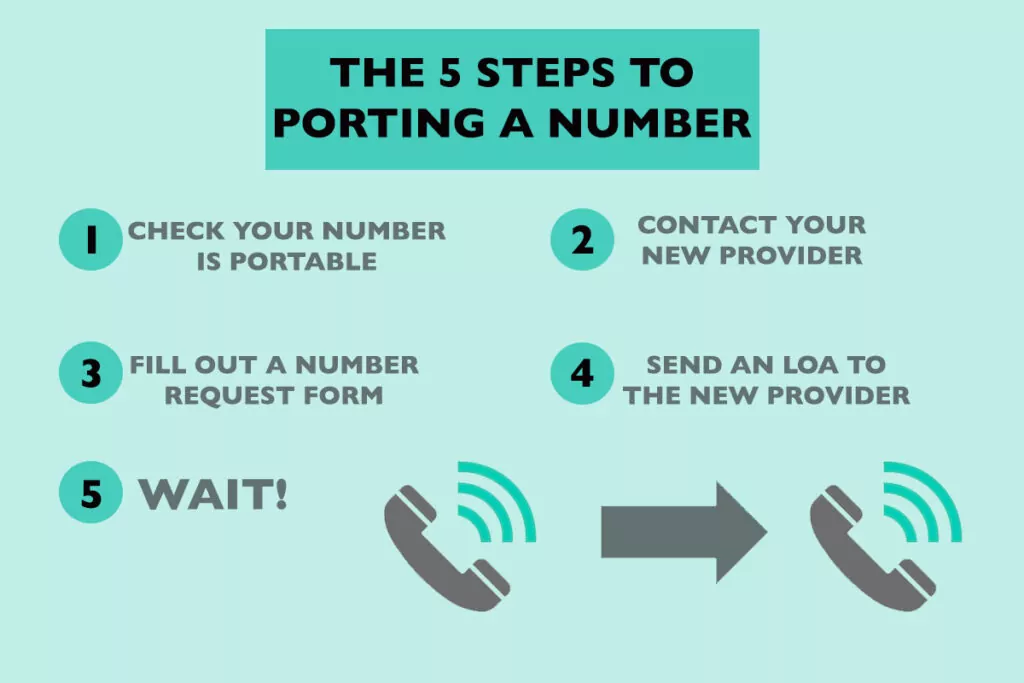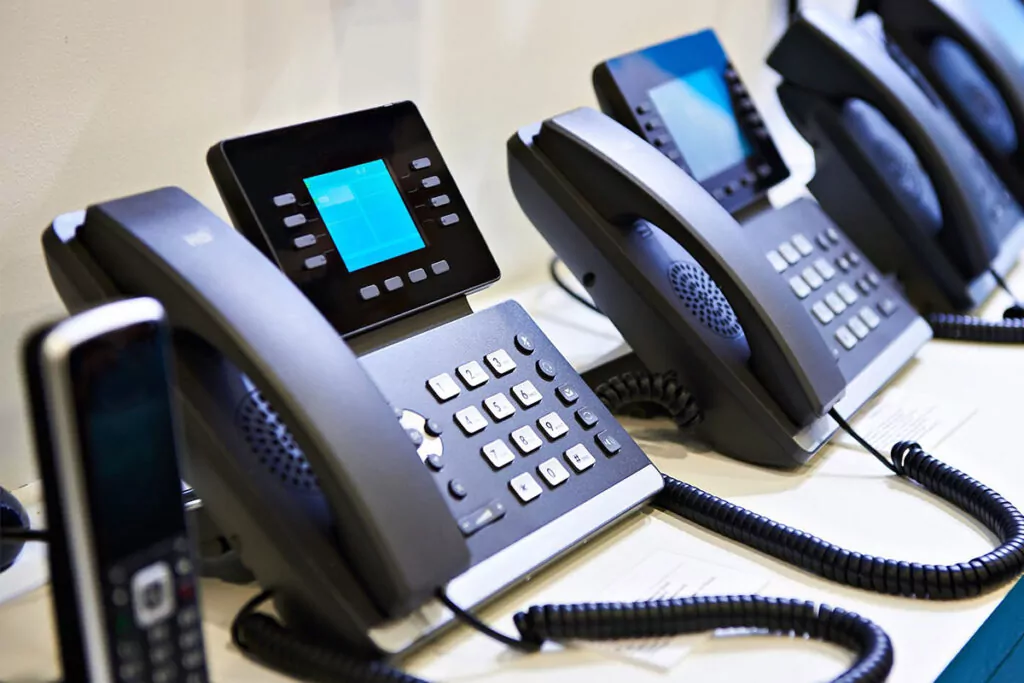When starting a business, investing in strong telephony and a memorable phone number is a great way to make your presence known and help your business develop in its earlier stages. But what happens when you want to switch providers to save money, get more features from your phone system or both? Being able to take your business communications with you – especially your phone number – is extremely important, to maintain your business presence while keeping a consistent number for the whole company. How do you keep your business phone number? The answer is number porting.
Transferring Your Business Landline To VoIP
Number porting is the process of moving an existing phone number from one communications provider and transferring it to another. If this sounds familiar, the number porting process is best associated with mobile numbers and mobile network carriers. Ever upgraded your mobile phone and wanted to keep your number? Or signed a contract with another network and not wanted the fuss of updating your contacts with your new digits? That’s number porting.
Before number porting was introduced in 1995, switching telecom or VoIP providers meant you had to adopt a new phone number. Because of this, many organisations stayed with their current suppliers to avoid the hassle of changing numbers. According to Ofcom, businesses and customers have the right – by law – to keep their phone numbers regardless of who they choose as a phone company.
Why would I be looking to port a number?
Number porting is a handy way for businesses to keep their existing phone numbers while switching provider, relocating or expanding offices. Let’s investigate a bit more.
Moving providers
There are many reasons that you and your business might be looking to move providers. Business owners might choose to switch because they’ve found a cheaper alternative, or their current provider isn’t offering competitive rates in comparison to others on the market. Another reason could be that your current service isn’t offering the best solution for your business. Looking elsewhere for a provider or phone system that offers better features or a VoIP / hosted solution might be more suited to your business needs.
Relocating
Despite the COVID-19 pandemic, the vast majority of businesses still need office premises. If you’re relocating, it’s easier to keep your business or VoIP phone number and port it over so you can keep a specific area code. Why? Firstly (and the most obvious reason), it’s easier and less fuss moving a number to a different location than having to adopt a new one and start your business communications from scratch. Secondly, a number with a specific area code gives the impression of locality and when you move, you may want to maintain this presence.
This also applies when opening other offices – perhaps for a different location or an additional team. Keeping or maintaining a fixed number for the whole company and its multiple offices means you can maintain your business ranking, status and brand presence.

How to port your business number
1. Check that your number is portable
To start the process, you need to ensure that your number is portable. There are two ways you can do this. The first is by simply asking your current provider. Service providers can help you test your number for portability. If the results come back saying that your number is eligible for porting, you can continue with the next steps.
The second is by checking your contract. It’s important to check your contract before you start porting to make sure you’re not obligated to stay with the company for a certain period of time. This reduces any risk of having to pay a fee or penalty if you terminate your contract early.
Note: DON’T cancel your contract until your business number has been successfully ported. If you cancel it before this is done, you might lose the number.
Why would my business number not be portable?
There are a few situations where your business phone number might not be portable. As mentioned above, if you’ve already cancelled your service with your old provider before porting happens, this makes the number inactive and it can be assigned to a new customer. Other reasons could be that your new supplier doesn’t have an agreement with your old one or that the new one doesn’t cover the rate centre associated with your number.
2. Contact your new provider (with a recent phone bill)
Next, you need to contact your new chosen service provider and tell them that you want to port your number. Before you contact them, make sure to secure a copy of your recent phone bill. Your phone bill contains all the information needed to process your request to port your current business number, including account details, billing telephone number, services purchased, service address and other numbers associated with the account.
Need support?
Talk to us today
Contact us
3. Fill out a Number Request Form
Filling out a Number Request Form enables your new provider to contact your old one and request your number. When a number is ported, the original provider transfers responsibility for the phone number and termination of calls to the new provider. A porting agreement and a number portability transit path needs to be in place between the two communication providers in order for the number to be transferred.
On the forms, you’ll need to provide your customer and account details, installation address, information about your current telephone service, main billing number, associated numbers, porting details and charges. When you’ve completed this, you’ll need to send this off with a copy of your recent bill as proof of ownership of the numbers. If you’re not a Gradwell customer and are considering moving your number over to us, chat to us now to start the process.
4. Send a Letter of Authorisation to your new provider
A Letter of Authorisation or (LOA) is a letter giving your new provider authority to port your number and obtain the required information that allows it to happen. This must contain all the relevant information, like your address and billing details. When your new supplier receives this, they’ll review your request and either start the porting process or reject it.
Why would my port be rejected?
Sometimes, carriers that are losing a phone number might reject your request. The most likely reasons are that your number might not be portable, or you might not have provided the right information for the port to go ahead. The best way to prevent your port from being rejected is to make sure the information you provide is exactly the same as what’s on your phone bill. It’s also a good idea to contact your current carrier to verify the information or ask them for a Customer Service Report.
5. Wait!
After the above has been completed, all you have to do is wait! The number porting process can take some time and differs depending on what type of number you’re transferring. Porting a business or VoIP number can take some time, especially if you’re transferring over multiple numbers and extensions. This can take anywhere from a few hours to a few months. You can check the porting status online and you’ll be notified when it’s completed by your new provider.

Can I keep my number when switching to VoIP?
If you’re switching from one VoIP provider to another, the number porting process is easily done by following the steps laid out above. But is it as easily done if you’re switching to VoIP from a non-VoIP phone like a landline?
What’s the difference between VoIP and landlines?
A landline is a conventional telecommunications connection made by cable laid across land. A landline phone uses a physical copper or optical fibre line to connect two or more points. VoIP offers an alternative way to making and receiving phone calls by using an internet connection that transmits data packets of information across a network. VoIP phone systems don’t require physical lines – unlike a landline.
Almost all businesses are upgrading to VoIP from landlines. Openreach plan to switch off their ISDN network by 2025 and will be migrating nearly all UK landlines to SIP Trunk based VoIP services. Understanding the porting process to VoIP is therefore essential to businesses.
Making the switch to a VoIP service
Numbers can be ported between wireless, IP and wired services. Making the switch to a VoIP service from the ISDN / landline is easily done by figuring out your business needs, how many phone extensions you need and if your internet connection can support VoIP.
Many providers (including Gradwell, of course!) provide robust and fast internet connections capable of supporting high-volume VoIP calls and will bundle these connections in with a new phone system, so you may find you save significantly by using one provider. Once you’ve done this research, you’ll need to choose a VoIP supplier who will take care of the migration for you. To plan the porting of your numbers, you’ll simply have to communicate this to your provider, and they will set up the process.
How does number porting help my business?
Continuity & identity
As a small or start-up business, continuity is vital especially if you’re about to undergo a big move like changing location. While a physical move can present a number of challenges to your customers, your phone number staying the same will keep them on board with your company. Customers who have been using your business for a while might get confused by a new number and it can make them think that you’re a completely different company or a ‘copycat’ business. Porting your business number causes less disruptions to you and your employees but most importantly, it keeps your customers on board with your brand.
Business materials
Your phone number is a big part of your business identity and is one of the identifying features of your company. Your business number will be seen everywhere – on your website, business cards, company signage and more. Therefore, if you’re making a big move, number porting is a great way to limit further costs to branding and administrative tasks. For example, if you were to completely switch numbers rather than number porting, you would have to change website information, email sign offs, marketing collateral and stationery. Keeping your current number is easier and it means you keep a consistent brand identity.

FAQs
What is number porting?
Number porting is the process of moving your phone number from one communications provider to another. It means you can keep your business phone number whether you’re moving locations, expanding offices or just want to change your service provider.
How long does it take to port a number?
Depending on how many numbers you’re porting, it can take a few hours up to a few months. The company assisting the process will notify you when the transfer is completed. Most porting requests with us are completed within 10-20 working days. We adhere to the Ofcom guidelines which are:
Single Line – 5 to 8 working days
Multi Line (No DDI Ranges) – 8 to 11 working days
Multi Line (With DDI Ranges) – 11 to 14 working days
Complex Port – 18 to 23 working days
Can I port a VoIP number?
Yes. As long as the number is portable, you can transfer it to another provider.
What does it mean if my port is rejected?
If your port is rejected, it means your request to move and keep your number has been unsuccessful. If your port is rejected by your current provider, you’ll be notified and told why. Depending on those reasons, you’ll need to discuss the next steps to go from there. Once you’re sure all the information you have is right, let the new provider know and they can resubmit the request for you. You might have to pay a resubmission fee each time the port is rejected/resubmitted depending on carriers.
Do I have to pay to port a number?
It completely depends on your current provider. You’ll need to confirm this with them and check the terms of your contract first before you start the process.
What information is needed to port a number?
You’ll have to speak to your current provider to make sure you have all the information you need. On our number porting form, we ask for your customer and account details, installation address, information about your current telephone service, main billing number, associated numbers, porting details and charges. You’ll need to send us a copy of a recent bill as well. If you’re porting your number to us, we have a guide on how to fill out our porting form.
When should I cancel with my current provider / existing service?
It’s important not to cancel your contract with your existing service until the porting process is complete. You risk losing the number if you cancel your contract early and you might also need to pay an early cancellation cost.
How do I port my number to Gradwell?
Chat to our team to learn more.
Want to make the switch to VoIP?
Chat to our team today to find out if our VoIP and hosted phone systems can help your business communicate better.


